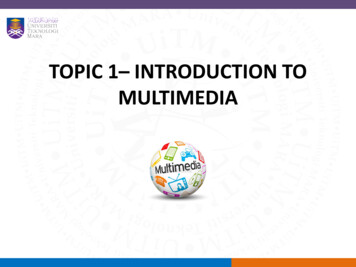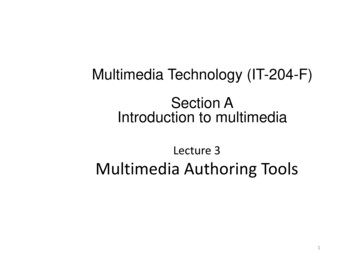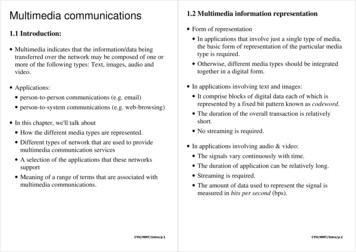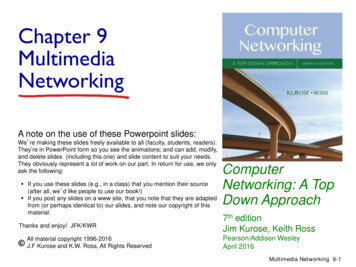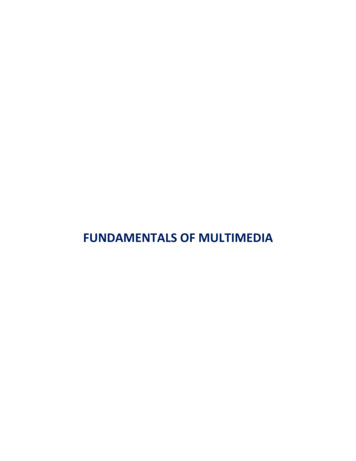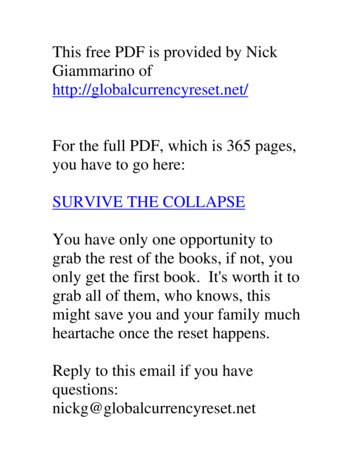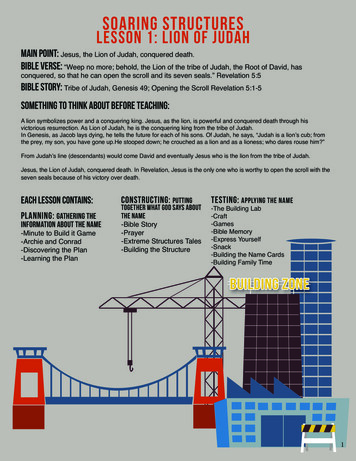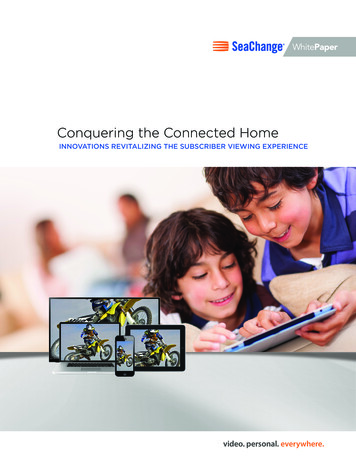
Transcription
WhitePaperConquering the Connected HomeINNOVATIONS REVITALIZING THE SUBSCRIBER VIEWING EXPERIENCEvideo. personal. everywhere.
White Paperexecutive summary Service providers’response throughthe adoption ofMedia Gatewayset-top boxtechnologies. The creation of theindustry RDK and itsrole in simplifyingset-top developmentand enhancingspeed to market forMedia Gateways.MULTI-SCREEN VIDEO IS GROWING.2013 Tablet Device2012Mobile netics ResearchAverage number of TVprograms watched on a.TVMobilePhoneTabletAVERAGE NUMBER OF TVPROGRAMS WATCHEDPC.BUT, TV IS STILL THE SCREEN OF CHOICE% WATCHING TV PROGRAM ON DEVICE ( 1 ) The emergence ofOTT providers in thepay-TV industry. This white paperdiscusses:The landscape of pay-TV is changing dramatically due to a number of industryand technology advances that impact the way subscribers watch video content,including the expansion of video across multiple screens, as well as the emergenceof Over The Top (OTT). Multi-screen viewing is growing dramatically and hasintroduced new ways for subscribers to access video and other content virtuallyanywhere. As a result of growing content fragmentation, subscribers are in needof offerings that provide easy access to a range of blended entertainment servicesthat combine live TV, video-on-demand, and OTT content with other media sourcesthrough a unified user experience across all screens. Cable and telco video serviceproviders are best positioned to offer a blended entertainment service experiencedue to their extensive investments in network infrastructure, strong relationshipswith content providers, and their consistent Quality of Service (QoS). Although“TV Everywhere” services are becoming more prevalent among service providers,it is evident that the television screen still commands the majority of subscribers’daily viewing time. Service providers are inclined to invest in new technologies thatenable increased speed, flexibility and control over the home viewing experience.While there’s overwhelming focus and chatter about the emergence of multiscreen, the big screen at home is still the most watched and most valuable. In fact,the emergence of the Reference Design Kit (RDK) is making it easier for serviceproviders to deploy new technologies that enhance the subscriber experiencethroughout the “connected home.”0%% of Broadband Households watchingat least one TV program on a.Parks Association 2012
NEW PAY-TV ENTRANTSThe emergence of OTT video delivery isallowing subscribers to enjoy a variety ofstreaming content through non-traditionalchannels with attractive pricing models.Popular OTT providers like Netflix, Hulu, Appleand Amazon drove the global OTT market past 8 billion in revenue1 in 2012. Subscribers canaccess OTT content using dedicated IP set-topboxes (such as Roku or AppleTV) as well asalmost any device with an Internet browser(PCs, tablets, game consoles, etc.).accepted jerky, low-bandwidth video forYouTube viewing over the past few years,high-quality HD and surround sound are thenorm for viewing the latest action movie.That said, OTT providers should still beconsidered a formidable threat thatservice providers ignore at their own peril.Subscribers find many features delivered bythe OTT providers to be compelling and thatquality is getting better each year.The biggest obstacle to even morewidespread success of OTT has been thatproviders have not yet figured out how toconsistently provide a superior Quality ofService (QoS) experience using the Internet.Buffering, latencies, and video quality allhave been shown to negatively impactviewer engagement. While subscribers haveAccording to a recent Viewer ExperienceReport2, in 2011 a 1% increase in bufferingresulted in 3 minutes less of viewing timeper view of long form content. In 2012, thatidentical 1% increase led to 8 minutes lost inviewing time per view for similar content.In 2012, global premium content brands lost 2.16 billion of revenue due to poorquality video streams and are expected to miss out on an astounding 20 billionthrough 2017.— Digital TV Research, Online TV and Video Forecast 1%BUFFERING3 Min20118 Min20120123456 12013 Viewer Experience Report8AMOUNT OF TIME LOST ON AVERAGEWITH AN INCREASE OF 1% BUFFERINGABI Research -worldwide-over-the-top-video-rev279
White PaperADOPTING MEDIA GATEWAYSAND SET-TOP INNOVATIONSService providers are developing new waysto enhance the connected home, and providea richer and more compelling viewingexperience for their subscribers. Whole-homeDVR, multi-screen video, content sharing andstreamlined user interfaces are all aspectsof this new wave of blended entertainmentservices.As service providers continue the transition toIP-based video delivery over their managednetworks, subscribers are benefitting fromthe removal of barriers between the TV andbroadband platforms, resulting in increasedconnectivity and integrated user interfaces forall screens and platforms within the home.Core to the delivery of these new blendedentertainment services is a new generationof set-top boxes that act as Media Gatewaysfor the home. A Media Gateway is a centralnetwork hub within the home for accessingbroadcast and on-demand video content, andmaking it accessible on any connected devicethroughout the home.Media Gateways typically contain multipletuners and can transcode both MPEG 2 andMPEG 4 (H.264) encoded video to variousformats used by tablets or other connecteddevices. In addition to making it easier toview and share quality content throughoutthe home network, Media Gateways providethe high QoS that subscribers have cometo expect from managed service providernetworks.Media Gateways can be configured as Headedor Headless. A Headed Media Gateway takesthe place of a traditional DVR set-top and isconnected directly to a TV, while adding thewhole-home DVR experience. A HeadlessMedia Gateway is closer in principle to a cablemodem that contains a hard disk drive but nodirect connection to a TV. A headless gatewaycan be placed anywhere in the home,whether it’s a closet or the garage, and servethe multiple screens and devices in a discreetfashion. In both cases, the Media Gatewayhandles conditional access for contentcoming from the public network and playingDigital Rights Management (DRM)-protectedvideo content to other devices in the home.To complete the whole-home mediaexperience, service providers are alsodeploying very small and simple “IP-only”client devices that consume live or recordedvideo content distributed by the gatewaythroughout the home. Via the gateway thesedevices present the service provider brandeduser experience that would otherwise beunavailable on smart TVs, or other DigitalLiving Network Alliance (DLNA) devices.By incorporating these technologiesthroughout the home, subscribers gain arich and unified experience in the home thatenables interconnectivity among screens andseamless blended entertainment services.Subscribers can access the content theywant to watch from browser-based UIs andaccess additional services and entertainmentthrough an app storefront similar to thosecreated by Roku, Apple and others.
Media GatewaytheconnectedhomeInternetCable OpHead-EndDOCSIS3 IPfeatures: HTML5/Webbased ApplicationEnvironment (Webkit,Opera, others) Multiple tunersWireless Router Whole homenetworking- EthernetQAM VideoEthernetIn-Home Gateway- MoCA (datatransmissionover coaxialcables)DLNAEthernet IPor MoCAIP ClientHDMI- W802.11(Wi-Fi forthroughputgreater than1 Gbps)Game Console DLNA for digitalmedia sharingbetween CE devicesHDMIHDMI Docsis 3.0-Broadbandsupport for highspeed data transferfrom the head end MPEG-2/H.264Decoders Transcoders forHLS supportREACHING THE TIPPING POINT Media Gateways are offering service providersflexibility, control and a range of othercapabilities. Therefore it’s no secret why serviceproviders are increasingly choosing theseappealing platforms for multi-screen videodistribution. ABI Research predicts the growthof Media Gateway shipments to triple from 2011through 2015, reaching upwards of 216 million3.The increasing investments made in MediaGateways and advanced set-top technologiesby service providers demonstrates the growingcommitment to advanced video networkconfigurations in the home.VIDEO SERVICE PROVIDERS ARE INCREASINGLYLEVERAGING MEDIA GATEWAYS FOR THEIRMULTI-SCREEN VIDEO DISTRIBUTION STRATEGIESInfonetics asked operators: How will you deliver multi-screen video?Headed videogatewayHeadless videogateway 0%Separate media streamingdevice connectedto a set-top boxNone of the aboveDon’t know201420133ABI Research0%0%10%20%30%40% 50%60%70%% OF OPERATORS PLANNING TO DELIVER MULTI-SCREEN VIDEO Infonetics Research, Residential Gateway Strategies: Global Service Provider Survey, April 2013
White PaperENTER THE RDKService providers are preparing to launch anew class of integrated whole-home devicesand services, based on a Media Gateway andIP Client architecture. One of the key buildingblocks in the rollout of these new servicesis a new specification for set-top operatingsystems and software called the ReferenceDesign Kit (RDK). The RDK is a specificationbased largely on open-source software (i.e.Linux, OpenGL ES, GStreamer), combined witha number of key components made availableby Comcast.Previously, developing and deploying thefoundational software for Media Gatewayswas a daunting task that took a tremendousamount of resources in order to createproprietary software solutions. The unificationof a standard software development stackhas ultimately helped provide the followingbenefits: Speed to Market - Increases commercialset-top time to market through fastervendor integration and reduces time spentcreating and launching new apps andservices Standardization - Consistency,predictability and common interfacesacross hardware vendors enabling serviceproviders more options to choose from Collaboration - Open and shared sourcecomponents that promote innovation andcontinuous improvementThe RDK specification is expected toultimately reduce costs associated withpurchasing set-top devices, as well as thework required to test and launch platforms.At a recent cable industry event, MattStrauss, SVP Digital and Emerging Platformsat Comcast, discussed the speed and ease atwhich the RDK allowed on-the-fly updates.He referenced that the Comcast X1 platformwhich leverages the RDK was updated 100times over18 months. Previously, withoutthe RDK, the platform could only be updatedonce during that same time span. The RDKdefines a standardized software base thatcan promote innovation and be optimized tomeet the needs of individual service providersgoing forward.On the benefits of the RDK — Over 18 months, the RDK enabledComcast to update the X1 platform 100 times. Previously, the platformcould only be updated once during a similar period.
ADOPTING THE RDKWhile the RDK is improving the software stackdevelopment process it is not a deploymentready, standalone configuration and oftenrequires some customization to fit a specificservice provider’s network environment.Service providers implementing the softwarestack for the first time typically require asignificant amount of custom integration andconfiguration to tailor new customer premiseequipment (CPE) devices to fit their complexenvironments.Service providers need to consider this andaccount for the following factors whenimplementing the RDK into their operation: Internationalization of network andsignaling protocols Service provider application frameworks Service provider-specific signaling protocolsand paradigms Interoperability with existing OCAP/tru2waydevices Cloud-based vs. local applicationexecution models Interactions with other CE devicesin the homeTo learn more about how SeaChange can help service providers implement the RDK,visit us at www.schange.com or on YouTube.
About SeaChange InternationalRanked among the top 250 software companies inthe world, SeaChange International (NASDAQ: SEAC)enables transformative multi-screen video servicesthrough an open, cloud-based, intelligent softwareplatform trusted by cable, IPTV and mobile operatorsglobally. Personalized and fully monetized videoexperiences anytime on any device, in the home andeverywhere, are the product of the Company’s superiorvideo platform, advertising and in-home offerings.SeaChange’s hundreds of customers are many of theworld’s most powerful media brands including allmajor cable operators in the Americas and Europe,and the largest telecom companies in the world.Headquartered in Acton, Massachusetts, SeaChangeis TL 9000 certified and has product development,support and sales offices around the world.Visit www.schange.comSeaChange International, Inc.50 Nagog Park, Acton, MA 01720 USAT 1.978.897.0100 F 1.978.897.0132www.schange.com7.23 2013 2013 SeaChange International, Inc. SeaChange is aregistered trademark of SeaChange International, Inc. Allother trademarks and registrations are property of theirrespective companies. While every effort is made to ensurethe information given is accurate, SeaChange does notaccept liability for any errors or mistakes which may arise.All features,specifications, system requirements and/orcompatibility with third party products described hereinare subject to change at any time without notice.
channels with attractive pricing models. Popular OTT providers like Netflix, Hulu, Apple and Amazon drove the global OTT market past 8 billion in revenue1 in 2012. Subscribers can access OTT content using dedicated IP set-top boxes (such as Roku or AppleTV) as well as almost any device with an Internet browser (PCs, tablets, game consoles, etc.).


